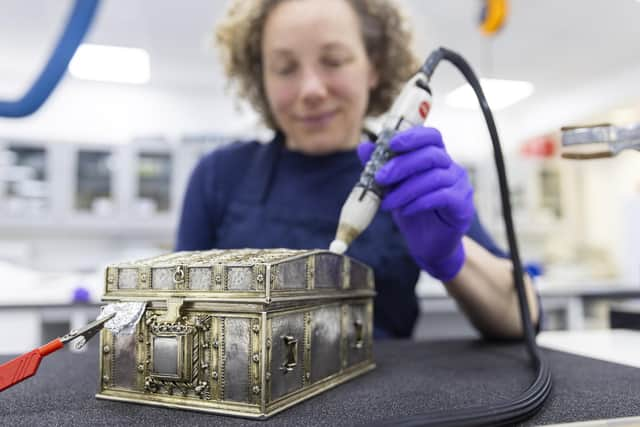Mary Queen of Scots' silver casket restored - but its secrets hold firm
For around 500 years, a silver casket said to have belonged to Mary, Queen of Scots has held its secrets.
Now, following its restoration, the remarkable object is to go on a mini tour of Scotland as its mysterious story – and its high beauty – is brought closer to the people.
Advertisement
Hide AdAdvertisement
Hide AdThe casket was acquired for the nation in 2022 after being sold by the family of the Dukes of Hamilton for £1.8 million. It was acquired by Anne, Duchess of Hamilton with a handwritten note penned 300 years ago outining the supposed connection to Mary, Queen of Scots and her long, drawn out downfall.


The casket – or one very much like it – was produced at a hearing ordered by Elizabeth I against Mary at Westminster in December 1568 where it was found to contain love poems and letters allegedly from Mary to her third husband, the Earl of Bothwell.
The letters implicated them both in a conspiracy to murder her second husband Lord Darnley. These documents became known as the Casket Letters, although the true author has long been debated.
The casket is now set to leave Edinburgh for display in Kirkcudbright and Stirling.
Dr Anna Groundwater, acting keeper of Scottish history and archaeology at National Museums Scotland (NMS), said: “One of Scotland’s national treasures, this extraordinary casket has been venerated as a relic of Mary, Queen of Scots for centuries, and I’m delighted that more people will have the opportunity to see it up close when it goes on tour later this year. Beyond its connections to one of Scotland’s most famous figures, it is a rare and spectacular piece of historic silver in its own right.”
It is thought the casket was given to Mary by her first husband, François II of France, and came to Scotland with her in 1561 after his death in 1560. Her inventories from this time list multiple examples of precious jewellery and other such valuable objects.
Made in Paris, probably between 1493 and 1510, the casket is said to be a superb and extremely rare work of early French silver, very little of which survives. It is likely its long-standing association with Mary has kept it preserved for more than 450 years.
NMS said the casket first appeared in records following Mary’s arrest in 1567 by the rebellious Confederate Lords, when it was discovered in the hands of Lord Bothwell’s servant. It was brought before the Scottish Privy Council where its lock was struck off to reveal its contents.
Advertisement
Hide AdAdvertisement
Hide AdThere is no record of what was found. But a year later the Earl of Moray – the illegitimate half brother of Mary – dramatically produced the same casket at Westminster, and it now contained the damning Casket Letters.
The authorship of the letters remains a subject of debate, but it is widely thought they were doctored.
The casket will go on show at Kirkcudbright Galleries from November 2 to April 27 next year, then at Stirling Smith Art Gallery & Museum from April 30–August 31, 2025. Its display at both venues is supported by the Weston Loan Programme with Art Fund.
Comments
Want to join the conversation? Please or to comment on this article.